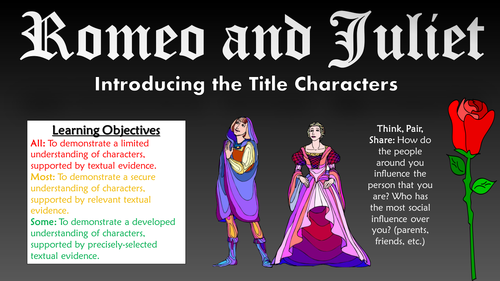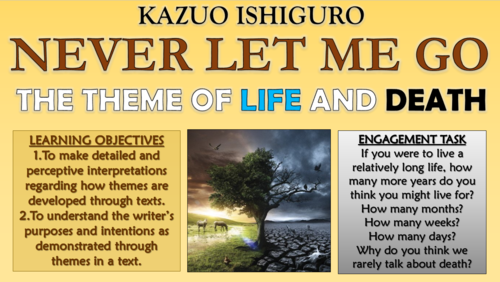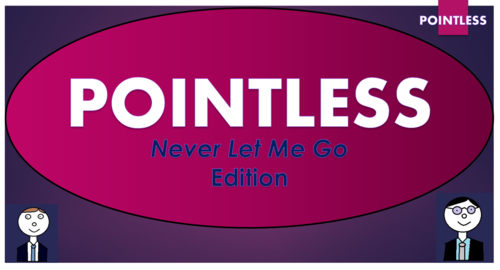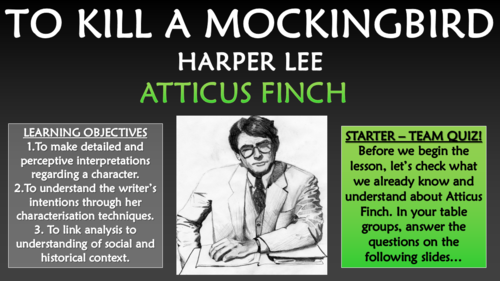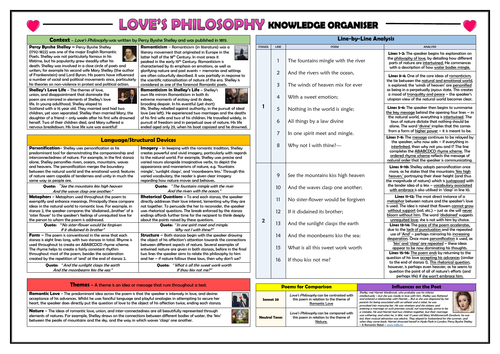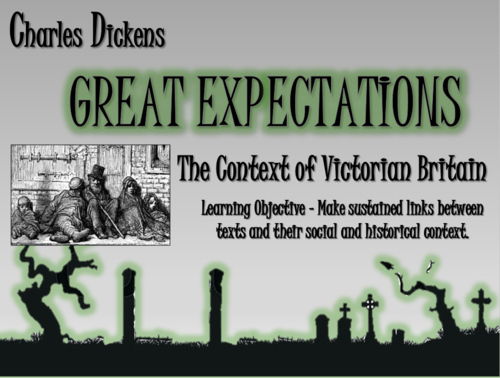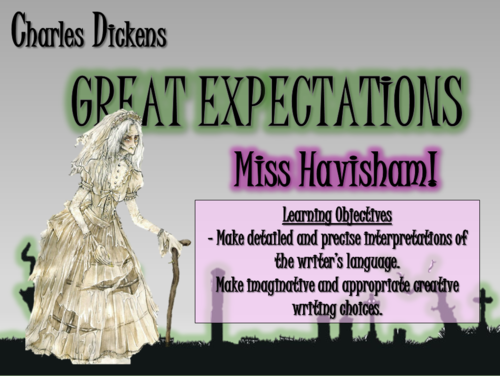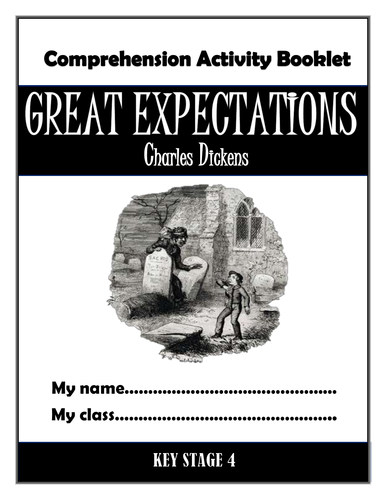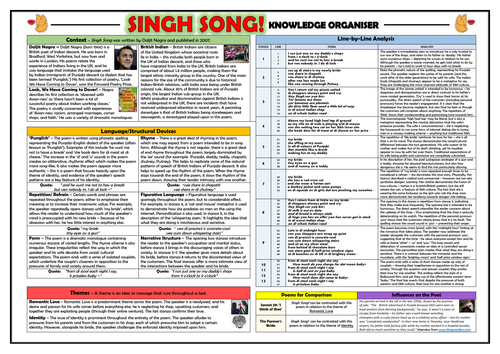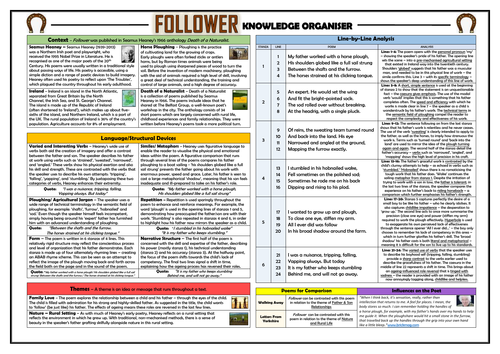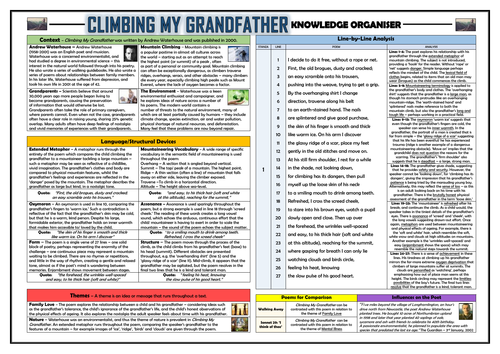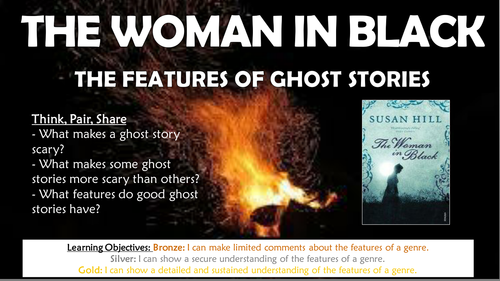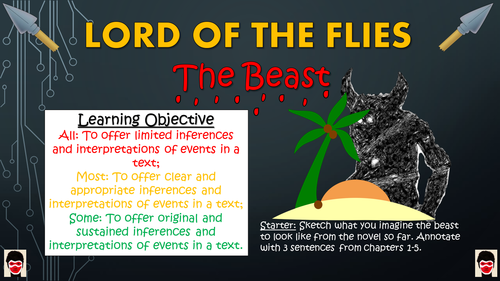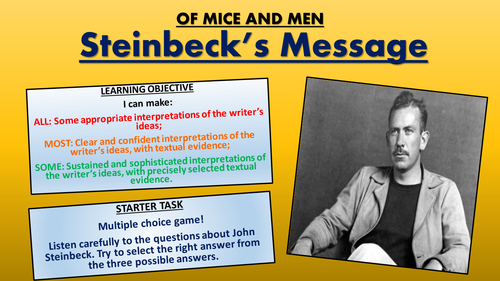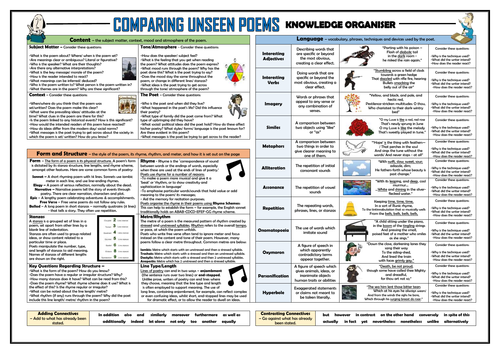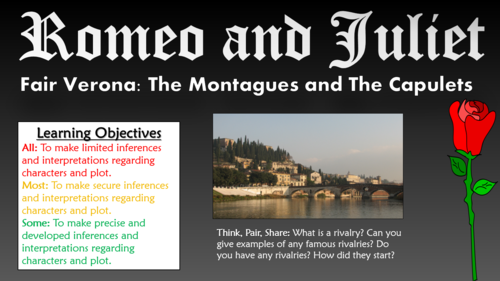
3k+Uploads
1972k+Views
2284k+Downloads
English language arts

Romeo and Juliet: Introducing the Title Characters (Analysis of Act I Scenes I-IV)
This interesting and engaging lesson enables students to gain a detailed understanding of Act I Scenes I-IV in William Shakespeare’s Romeo and Juliet, in which the title characters (Romeo and Juliet) are introduced. Students learn to develop sustained and developed interpretations regarding both the characterisation and the plot development of both characters. They partake in tasks such as comprehension questions, character case studies, and a diary writing exercise to build these skills.
The lesson utilises a range of tasks, that require students to be attentive and interactive learners. It follows this learning journey:
- Defining the key term 'social influences' and apply this to both Shakespearean and modern contexts;
- Reading and interpreting Act 1 Scene 1 to Act 1 Scene 4, and establishing how Shakespeare introduces and develops both Romeo and Juliet;
- Reflecting upon the key social influences that are acting upon both characters;
- Making detailed inferences/ interpretations into clues about characterisation and social structure through a case study;
- Showing an understanding of character viewpoint and reasoning through the diary writing task;
- Peer/self evaluating the learning in the lesson.
Included in this resource pack are:
- A well-presented, thorough, and informative, whole-lesson PowerPoint presentation;
- Resources for the reading and interpreting activity - full transcript of scenes with space for notes;
- A case study template
- A challenging and thought-provoking worksheet, and an answer sheet for the teacher.
- A detailed lesson plan for the teacher.
All images in this resource are licensed for commercial use, and are cited on the final slide of the lesson presentation.

Never Let Me Go Comprehension Activities Booklet!
This resource booklet contains a wide range of age-appropriate, engaging, and meaningful comprehension activities for use throughout the reading of Kazuo Ishiguro’s ‘Never Let Me Go.’ Teachers have found them particularly useful in exam revision, comprehension tasks, or guided reading sessions. They are perfect for aiding the progress of students towards meeting the KS4 expectations within the new National Curriculum framework - this makes the tasks suitable for all examining bodies. Students have found these resources extremely engaging, and for teachers there is explicit information within each task regarding which comprehension strands the task is designed to demonstrate. They also relate to key extracts, characters, and themes from the story, ensuring that students gain a deep understanding of the text.
Activities within the booklet include:
‘Context: Cloning and the Future’ - to aid students with ‘Drawing on knowledge of the purpose, audience and context of the writing, including its social, historical and cultural context and the literary tradition to which it belongs, to inform evaluation;’
‘Ishiguro’s Description’ - to aid students with ‘Analysing a writer’s choice of vocabulary, form, grammatical and structural features, and evaluating their effectiveness and impact;’
‘Madame, Tommy, and Ruth’ - to aid students with ‘Seeking evidence in the text to support a point of view, including justifying inferences with evidence;’
‘Editing the Text’ - to aid students with ‘Making an informed personal response, recognising that other responses to a text are possible and evaluating these.’
Plus many, many more activities (the booklet is around 30 pages in length!) I’ve also added it as a PDF in case the formatting differs on your computer.
All images are licensed for commercial use, and are cited on a separate document (included).

Never Let Me Go - The Human Cloning Debate!
This engaging and informative lesson enables students to explore and consider the ideas and perspectives regarding human cloning in Kazuo Ishiguro’s Never Let Me Go. In particular, students research and understand the key factors in the human cloning debate, interpret and analyse how Ishiguro applies these concepts throughout Never Let Me Go, and then use these influences to argue their own viewpoint on the human cloning debate. .
The lesson follows a step-by-step learning journey, in which children learn through:
Understanding and further researching the key factors in the human cloning debate;
Linking their understanding of the human cloning debate to what they read in the novel;’
Answering comprehension questions about human cloning in Never Let Me Go;
Analysing Ishiguro’s key intentions in his depiction of life for clones in the novel;
Applying their understanding of human cloning to their own writing to argue piece;
Debating as a class whether human cloning should be allowed using their research notes and argument points;
Peer assessing each other’s learning attempts;
Included is:
Whole lesson PowerPoint - colourful and comprehensive;
Guided research template
Selected extracts (from chapters 7, 12, 14 and 22);
Writing to Argue Structure Strip;
Writing to Argue Helpsheet;
Comprehensive Lesson Plan.
There are also opportunities for group learning, speaking and listening, peer assessment, and whole class discussion. I originally used these resources with year 10 and 11 classes, however colleagues have used them for between year 9 and year 13 with some adaptations.
All images are licensed for commercial use, and image rights are listed on the last page of the presentation.

Never Let Me Go - Ishiguro's Use of Language!
This engaging and informative enables students to make precise and detailed interpretations of Kazuo Ishiguro’s language choices throughout Never Let Me Go. In particular, students identify and analyse the effect of Ishiguro’s language in his description in the novel of the boat on the marsh, using their understanding of various language devices, before applying these concepts to their own descriptive writing attempts.
The lesson follows a step-by-step learning journey, in which children learn through:
Defining and exemplifying the descriptive writing techniques, through a fun and interactive activity;
Identifying the language techniques that Ishiguro uses in his description of the boat on the marsh in the novel;’
Analysing the effectiveness of Ishiguro’s descriptive writing;
Creating their own descriptions of settings, using Ishiguro’s model example, a structure strip, and the techniques that they have gathered over the course of the lesson;
Peer assessing each other’s learning attempts;
Included is:
Whole lesson PowerPoint - colourful and comprehensive;
Card sorting cards
Selected extract (from chapter 19);
Descriptive Writing Structure Strip;
Descritpive Writing Helpsheet;
Comprehensive Lesson Plan.
There are also opportunities for group learning, speaking and listening, peer assessment, and whole class discussion. I originally used these resources with year 10 and 11 classes, however colleagues have used them for between year 9 and year 13 with some adaptations.
All images are licensed for commercial use, and image rights are listed on the last page of the presentation.

Never Let Me Go - The Theme of Life and Death!
This engaging and informative lesson enables students to make clear, detailed and well-informed interpretations of the theme of life and death in ‘Never Let Me Go.’ In particular, students develop their understanding of how this theme is introduced and developed, drawing on a varied range of textual evidence from across the novel, before demonstrating their understanding of how the theme is used to get across Ishiguro’s key ideas.
The lesson follows a step-by-step learning journey, in which children learn through:
Reading an extract detailing the introduction to the theme of life and death in the novel, and answering comprehension questions to demonstrate understanding;
Tracking and analysing the development of the theme of life and death throughout the novel, through a interesting timeline task;
Understanding how the theme of life and death is used to portray Ishiguro’s key meanings and ideas;
Using their deep understanding of the theme of life and death to answer an exam-style question;
Peer assessing each other’s learning attempts.
Included is:
Whole lesson PowerPoint - colourful and comprehensive;
Novel TImeline Template;
Selected extract (from chapter 7);
Essay Template
Comprehensive lesson plan.
There are also opportunities for group learning, speaking and listening, peer assessment, and whole class discussion. I originally used these resources with year 10 and 11 classes, however colleagues have used them for between year 9 and year 13 with some adaptations.
All images are licensed for commercial use, and image rights are listed on the last page of the presentation.

Never Let Me Go Pointless Game!
Based on the popular game show ‘Pointless’, this resource is perfect for use as a whole lesson resource, enrichment option, or revision tool. Editable, so that you can change to any other topic or change questions. (I’ve also added a blank template so that you can make your own games from scratch). Containing almost 30 slides of sound clips and suitably challenging questions, this resource is effective at both promoting engagement and enhancing learning. There are several full rounds of questions to build or revisit knowledge of characters, plot, and themes in ‘Never Let Me Go.’
Round 1. The characters in Never Let Me Go
Round 2. Quotations from the text
Round 3. Settings and Objects
Round 4. Themes in Never Let Me Go
The nature of this game ensures that the resource can challenge students of all levels.
A blank template has also been added, so that you can create your own games!

To Kill a Mockingbird - Atticus Finch!
This engaging and informative lesson enables students to make clear, detailed and well-informed interpretations of Atticus Finch’s character in To Kill a Mockingbird. In particular, students develop their background understanding of his role in the novel, make precise inferences about his character using evidence from the text, and relate their findings to the social and historical context of the American South in the 1930s.
The lesson follows a step-by-step learning journey, in which children learn through:
Taking part in a fun quiz in order to gain/recap knowledge about Atticus Finch’s background information (e.g. family history, occupation, etc.);
Reading selected extracts from the text and answering comprehension questions about Atticus’ character;
Identifying and analysing Atticus’ character traits in relation to social/historical context;
Understanding Lee’s intentions/messages in presenting Atticus in the way that she did;
Peer assessing each other’s learning attempts;
Included is:
Whole lesson PowerPoint - colourful and comprehensive;
Interesting Atticus Finch development worksheet;
Selected extracts (from chapters 3, 11 and 20);
Essay template
Comprehensive lesson plan.
There are also opportunities for group learning, speaking and listening, peer assessment, and whole class discussion. I originally used these resources with year 10 and 11 classes, however colleagues have used them for between year 8 and year 13 with some adaptations.
All images are licensed for commercial use, and image rights are listed on the last page of the presentation.

Love's Philosophy Knowledge Organiser/ Revision Mat!
This detailed and visually-appealing resource offers a complete reference point for students learning or revising Percy Bysshe Shelley’s love and relationships poem 'Love’s Philosophy.’ It contains comprehensive sections on:
Context;
Line-by-Line Analysis;
Poetic Devices/ Language Devices;
Themes;
Form/Structure;
Poems for Comparison;
The Poet’s Influences.
Key words and ideas are underlined for easy reference. The resource is designed to be printed onto A3, and is provided as both a PDF and a Word version (so that you can edit if you want to). All images used are licensed for commercial use and are cited on a separate document (included).

Great Expectations: The Context of Victorian Britain!
This engaging and informative lesson enables students to make sustained and developed links between Dickens’ Great Expectations and its social and historical context. In particular, students learn about the contrasts between the lives of the rich and poor in Victorian society, crime and the justice system, and the implications of an underdeveloped healthcare system. They then link this understanding to what they read in the opening of the novel.
The lesson follows a step-by-step learning journey, in which children learn through:
- Understanding key information about Charles Dickens, his life, and influences;
- Researching and sharing key contextual understanding about the rich, poor, healthcare, crime and the justice system in the 19th Century;
- Reading extracts from the opening of 'Great Expectations' and identifying evidence of contextual influences;
- Analysing how Dickens presents his views about the cruelty of 19th Century life through the opening of the text;
- Peer assessing each other's learning attempts.
Included is:
- Whole lesson PowerPoint - colourful and comprehensive;
- Extract - Opening of Great Expectations;
- Template for researching 19th Century life (and completed answer sheet for teachers);
- Analysis template with success criteria for creating well-structured responses;
- Comprehensive lesson plan.
All documents are attached as Word and PDF in case formatting differs on your computer.
There are also opportunities for group learning, peer assessment, and whole class discussion. This was originally taught to mixed ability year 10 groups, but can easily be differentiated for groups of different ages and abilities.
All images are licensed for commercial use, and image rights are listed on the last page of the presentation.

Great Expectations: Miss Havisham!
This engaging and informative lesson enables students to make detailed and precise interpretations of the language used by Charles Dickens in describing Miss Havisham in Great Expectations. In particular, students analyse the interesting vocabulary choices, similes, metaphors, and other language devices employed to depict Miss Havisham’s decayed appearance and surroundings, before utilising the techniques in a similar manner through their own vivid descriptions.
The lesson follows a step-by-step learning journey, in which children learn through:
- Defining and exemplifying each of the descriptive language devices;
- Reading extracts from 'Great Expectations' in which Miss Havisham is described, identifying the descriptive devices used;
- Precisely and in detail, analysing how Dickens uses each of the descriptive language devices for effect;
- Creating their own imaginative and appropriate descriptions of mysterious characters, using a wide range of descriptive language devices;
- Peer assessing each other's learning attempts.
Included is:
- Whole lesson PowerPoint - colourful and comprehensive;
- Extracts from Great Expectations;
- Cards for card-sorting activity;
- Analysis template with success criteria for creating well-structured responses;
- Blank character profile template;
- Model example character profile template;
- Writing to describe helpsheet;
- Comprehensive lesson plan.
All documents are attached as Word and PDF in case formatting differs on your computer.
There are also opportunities for group learning, peer assessment, and whole class discussion. This was originally taught to mixed ability year 10 groups, but can easily be differentiated for groups of different ages and abilities.
All images are licensed for commercial use, and image rights are listed on the last page of the presentation.

Great Expectations Comprehension Activities Booklet!
This resource booklet contains a wide range of age-appropriate, engaging, and meaningful comprehension activities for use throughout the reading of Charles Dickens' 'Great Expectations.' Teachers have found them particularly useful in exam revision, comprehension tasks, or guided reading sessions. They are perfect for aiding the progress of students towards meeting the KS4 expectations within the new National Curriculum framework - this makes the tasks suitable for all examining bodies. Students have found these resources extremely engaging, and for teachers there is explicit information within each task regarding which comprehension strands the task is designed to demonstrate. They also relate to key extracts, characters, and themes from the story, ensuring that students gain a deep understanding of the text.
Activities within the booklet include:
- 'Context: 19th Century Britain' - to aid students with 'Drawing on knowledge of the purpose, audience and context of the writing, including its social, historical and cultural context and the literary tradition to which it belongs, to inform evaluation;'
- 'Dickens' Description' - to aid students with 'Analysing a writer’s choice of vocabulary, form, grammatical and structural features, and evaluating their effectiveness and impact;'
- 'Abel Magwitch' and 'Miss Havisham' - to aid students with 'Seeking evidence in the text to support a point of view, including justifying inferences with evidence;'
- 'Editing the Text' - to aid students with 'Making an informed personal response, recognising that other responses to a text are possible and evaluating these.'
Plus many, many more activities (the booklet is around 30 pages in length!) I've also added it as a PDF in case the formatting differs on your computer.
All images are licensed for commercial use, and are cited on a separate document (included).

Singh Song! Knowledge Organiser/ Revision Mat!
This detailed and visually-appealing resource offers a complete reference point for students learning or revising Daljit Nagra’s love and relationships poem 'Singh Song.’ It contains comprehensive sections on:
Context;
Line-by-Line Analysis;
Poetic Devices/ Language Devices;
Themes;
Form/Structure;
Poems for Comparison;
The Poet’s Influences.
Key words and ideas are underlined for easy reference. The resource is designed to be printed onto A3, and is provided as both a PDF and a Word version (so that you can edit if you want to). All images used are licensed for commercial use and are cited on a separate document (included).

Follower - Seamus Heaney - Knowledge Organiser/ Revision Mat!
This detailed and visually-appealing resource offers a complete reference point for students learning or revising Seamus Heaney’s love and relationships poem 'Follower.’ It contains comprehensive sections on:
Context;
Line-by-Line Analysis;
Poetic Devices/ Language Devices;
Themes;
Form/Structure;
Poems for Comparison;
The Poet’s Influences.
Key words and ideas are underlined for easy reference. The resource is designed to be printed onto A3, and is provided as both a PDF and a Word version (so that you can edit if you want to). All images used are licensed for commercial use and are cited on a separate document (included).

Climbing My Grandfather Knowledge Organiser - Revision Mat!
This detailed and visually-appealing resource offers a complete reference point for students learning or revising Andrew Waterhouse’s love and relationships poem Climbing My Grandfather.’ It contains comprehensive sections on:
Context;
Line-by-Line Analysis;
Poetic Devices/ Language Devices;
Themes;
Form/Structure;
Poems for Comparison;
The Poet’s Influences.
Key words and ideas are underlined for easy reference. The resource is designed to be printed onto A3, and is provided as both a PDF and a Word version (so that you can edit if you want to). All images used are licensed for commercial use and are cited on a separate document (included).

The Woman in Black: The Features of Ghost Stories!
This engaging and informative lesson enables students to show a detailed and sustained understanding of the conventions of effective ghost stories, through analysis of extracts from Susan Hill's 'The Woman in Black.' They study how individual features of subject matter (such as the setting and the hero) and language (e.g descriptive features) are used to create suspense and tension in the mind of the reader.
The lesson follows a step-by-step learning journey, in which children learn through:
- Defining the key elements of ghost stories;
- Planning a ghost story using the key features;
- Identifying the elements of ghost stories within key extracts of The Woman in Black;
- Analysing the effectiveness of Hill's features of ghost stories in The Woman in Black;
- Peer assessing each other's learning attempts.
Included is:
- Whole lesson PowerPoint - colourful and comprehensive;
- Extracts from the blurb and Chapter 1 of The Woman in Black;
- Template for creating their own ghost stories;
- Analysis template with success criteria for creating well-structured responses;
- Comprehensive lesson plan.
There are also opportunities for group learning, peer assessment, and whole class discussion. This was originally taught to middle-ability year 10 groups, but can easily be differentiated for groups of different ages and abilities.
All images are licensed for commercial use, and image rights are listed on the last page of the presentation.

Lord of the Flies: Golding's Language Devices
This interesting and highly-stimulating lesson enables students to gain a clear understanding of the language choices utilised by William Golding’s throughout Chapters 4 and 5 of Lord of the Flies, with particular reference to the advanced figurative language employed in the descriptive sections of the text. Students also learn to analyse the effects of key language choices, with reference to Golding's key intentions throughout the novel.
The lesson follows a clear, logical, bite-size learning journey, which guides students towards differentiated learning objectives. Over the course of this journey, they become able to:
- Define, identify, and exemplify different types of language devices;
- Explain the effects of different language devices on meanings and different audiences;
- Read and understand Chapters Four and Five of the play, with a particular focus upon how Golding utilises language devices to demonstrate the changing feelings and mindsets of the boys on the island;
- Analyse key quotations which utilise effective descriptive devices;
- Analyse the effectiveness of Golding's language devices;
-Peer assess each other's learning attempts.
This resource pack includes:
- A visually engaging whole-lesson PowerPoint presentation;
- Detailed worksheets, with answer sheets where necessary;
- Links to the extracts of the text needed for the lesson (Chapters Four and Five in this case);
- Card sort cards;
- A detailed lesson plan, complete with what the teacher and students should aim to achieve at each stage of the lesson.
All images are licensed for commercial use, and are cited on the final slide of the PowerPoint.

Lord of the Flies: The Beast
This interesting and highly-stimulating lesson enables students to make important inferences and interpretations regarding ‘the beast’ that is referred to by the boys on the island throughout William Golding’s novel Lord of the Flies. In particular, students form opinions of what the beast may represent, based upon key evidence throughout the text.
The lesson follows a clear, logical, bite-size learning journey, which guides students towards differentiated learning objectives. Over the course of this journey, they become able to:
- Establish, sketch, evidence, and share their initial interpretations of the beast;
- Collaborate with others to form rational and substantiated opinions;
- Read and understand Chapters Six and Seven of the play, with a particular focus upon how Golding utilises the beast to depict other concepts and notions;
- Analyse key quotations which refer to the beast in relation to each of the characters;
- Give appropriate and sustained interpretations and inferences regarding altering views towards Golding's use of the beast;
-Peer assess each other's learning attempts.
This resource pack includes:
- A visually engaging whole-lesson PowerPoint presentation;
- Detailed worksheet;
- A scaffolded essay template;
- Links to the extracts of the text needed for the lesson (Chapters Six and Seven in this case);
- A detailed lesson plan, complete with what the teacher and students should aim to achieve at each stage of the lesson.
All images are licensed for commercial use, and are cited on the final slide of the PowerPoint.

Of Mice and Men: Steinbeck's Message
This engaging and interesting lesson aims to improve students' knowledge of John Steinbeck's key messages in his novella Of Mice and Men. It also aims to build their skills in retrieving information from texts, considering the outcomes about the characters, and making precise and confident interpretations about Steinbeck's intentions.
The lesson uses a range of tasks, that require students to use their visual and interpersonal skills. It follows this learning journey:
- Investigating the life of John Steinbeck, including his influences, experiences, and beliefs;
- Finding relevant quotations to ascertain which characters fulfilled their dreams, and what this could tell us about Steinbeck's message;
- Completing analysis paragraphs on how Steinbeck reveals his message through the final chapters of the text, using a template and a success criteria;
- Evaluating each others' argumentative attempts.
The resource includes a comprehensive and visually engaging PowerPoint presentation, a worksheet to decipher which characters achieved their dreams, a template and success criteria for the main task, and a lesson plan/ teacher guidance sheet.
All images in this resource are licensed for commercial use, and are cited on the final slide of the lesson presentation.
You can choose to buy this resource alone, or as part of the 'Of Mice and Men - All Lessons and Scheme' bundle, which contains seven full lessons, resources, teachers notes, and PowerPoint presentations, plus a Pointless Of Mice and Men game, for just £5!

Comparing Unseen Poetry Knowledge Organiser/ Revision Mat!
This detailed and visually-appealing resource offers a complete reference point for students preparing for the ‘Unseen Poetry’ elements of English Literature examinations. It is ideal for GCSE and A Level students, as it contains detailed and comprehensive sections (including explanations, examples and key questions) on:
Content -Subject Matter, Context, Tone, Atmosphere, The Poet;
Language - Similes, Metaphors, Interesting Adjectives, Interesting Verbs, Imagery, Onomatopoeia, Alliteration, Assonance, Personification, Hyperbole, Oxymoron, Repetition;
Form and Strcuture - Common Forms, Rhyme/ Rhyme Schemes, Metre, Rhythm, Stanzas, Line Type, Line Length.
Plus lists of Adding Connectives and Contrasting Connectives for use when comparing.
Key words and ideas are underlined for easy reference. The resource is designed to be printed onto A3, and is provided as both a PDF and a Word version (so that you can edit if you want to). All images used are licensed for commercial use and are cited on a separate document (included).

Romeo and Juliet: The Montagues and The Capulets (Analysis of Act 1 Scene 1)
This lesson enables students to gain a detailed understanding of the opening scene in William Shakespeare’s Romeo and Juliet. Students learn to make sustained and developed inferences and interpretations in relation to both characters and plot. Students also produce a family tree to demonstrate the relationships between the characters, using colourful and interesting images and resources.
The lesson utilises a range of tasks, that require students to be attentive and interactive learners. It follows this learning journey:
- Defining the key term 'feud' and apply this understanding to a range of contexts;
- Reading and interpreting the prologue and Act 1 Scene 1, and establishing how Shakespeare sets the scene in Verona;
- Reflecting upon what effect this may have had on audiences at the time;
- Making detailed inferences/ interpretations into clues about characterisation and social structure;
- Analysing Shakespeare's intentions in including such an energetic scene at the outset of the play;
- Peer/self evaluating the learning in the lesson.
Included in this resource pack are:
- A well-presented, thorough, and informative, whole-lesson PowerPoint presentation;
- Resources for the reading and interpreting activity - full scene transcript with space for notes;
- A template to help scaffold the main task, complete with P.E.E instructions;
- A family tree template and character list;
- A challenging and thought-provoking worksheet, and an answer sheet for the teacher.
All images in this resource are licensed for commercial use, and are cited on the final slide of the lesson presentation.

